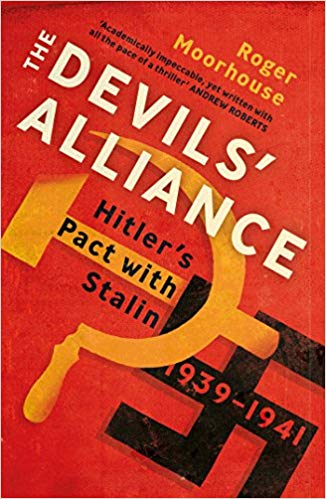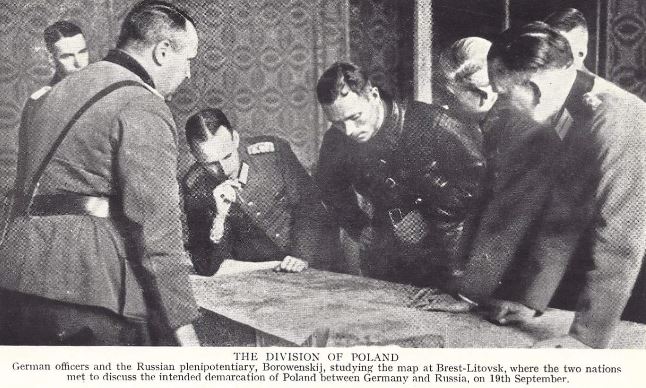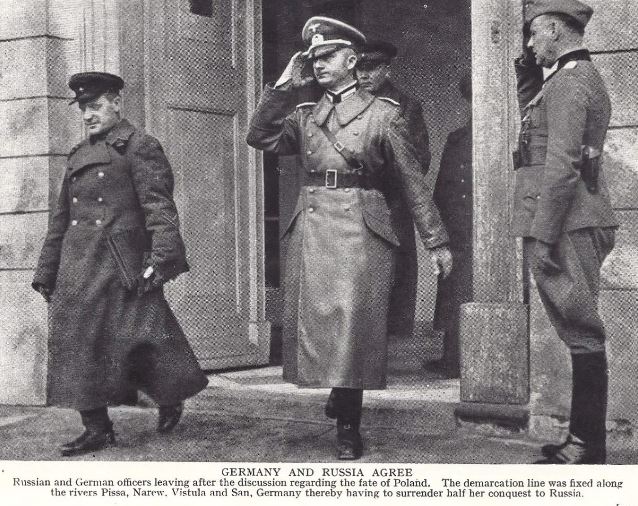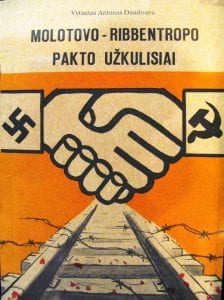The 1st Independent Polish Parachute Brigade
(1 Samodzielna Brygada Spadochronowa)
Molotov-Ribbentrop Agreement
Germany & Russia End Hostilities Towards Each Other
Before we discuss the Molotov-Ribbentrop agreement, a little background to the style of Russian politics is in order. I call this "Russia's Dirty Double Dealing" because there is a complete disregard for morals and ethics with only one agenda - Russia's fight for domination. Lets now look at this.

A book worth reading to understand the Molotov-Ribbentrop further.
Russia's Dirty Double Dealing
Prior to 1939 the USSR had been attempting a strategic alliance with Britain, France, Poland and Romania in an attempt to halt the arming of Nazi forces.
Meantime Russia is also at the same time secretly working with Germany in what was to become the Molotov-Ribbentrop agreement, a plan to invade Poland.
In effect, Russia knew it could not take the whole of Poland, in part because his would cause Austria and Germany to become enemies of Russia (with a possible military assault) as had happened in previous land disputes that are detailed in the forming and partitions of Poland section.
So Stalin formed a plan to split Poland, with Germany taking one part and Russia the other. However, Stalin did not want Germany to become powerful and thus colluded with foreign powers to ensure that the arming of Germany was managed at an acceptable level, i.e one that Stalin could deal with.
But Stalin never admitted to these foreign powers that he planned to share Poland with Germany. Neither did he tell Germany he was seeking to minimise or manage their military might. This makes Stalin a "puppet master" someone who sought to control both sides through clever and manipulative agreements.
Beginning Of The Molotov-Ribbentrop Pact
On 23 August 1939 Germany and Russia ended their hostilities towards each other and agreed on a "neutrality pact" to ensure more peaceful relations between themselves.
This neutrality pact was named after the officials who signed it, these being Germany's foreign minister Joachim Von Ribbentrop and Russia's Vyacheslav Molotov, thus the agreement came to be known as the "Molotov-Ribbentrop" agreement.
The Moment Mass Murder Was Legalised

Detail: Molotov is signing, Ribbentrop (left) watches and Stalin smiles (Behind Ribbentrop).

Until the fall of communism in 1989, this agreement was not widely known about, however in 1989 when communism fell, the facts came out and in time the agreement was formally acknowledged by Russia and denounced.

In this fateful moment of the signing of the agreement, the fate of millions of Polish people was sealed by a pen; families torn apart, deportated, repressed, sent to hard labour, and even executions.
2 Superpowers Increase Their Power
Germany and Russia had been merrily getting on with each other (for once!) and like greedy overlords they now sneakily conspired to turn their war mongering capabilities on Poland.
Written into their Molotov-Ribbentrop agreement was a secret agreement between Russia and Germany to divide Poland, Lithuania, Latvia, Estonia, Finland and Romania amongst themselves both politically and also by "re-aligning territories", which is a posh word for moving borders, seizing land that in many cases belonged to Polish farmers and families, even mine.
This wasn't anything particularly new because there had been plenty of invasions and re-apportionment of Polish land and borders in previous years. However, this plan was executed on a such mass scale that mass displacements of people would result, forever changing world demographics.
Invaded By Germany (The September Campaign)
Germany made the first move under the Molotov-Ribbentrop agreement by invading Poland from the west on 1st Sept 1939.
Thus began a horrendous life changing experience as Polish men went into a defensive war in what became known as "The September Campaign" fighting Germans in the west (The Kresy region was largely unaffected by this, being in the East).
The Poles living in the west were captured by the Germans and sent to concentration camps such as Auchswitz and Birkenau (whilst the Poles in the East were rounded up by the Russians and deported to Siberia and Kazakhstan).
Invaded By Russia
Russia was supposed to invade from the east on that same day, however they stalled their part of the invasion as they were busy finishing fighting a war against the Japanese and needed their troops assistance there.
On Sept 17 1939 Joseph Stalin ordered the Russian army to invade Poland from the east, mainly in the Kresy region (East of Bialystok), which is where my grandfathers family were.
Faced with 2 fronts of invading nations, Polands government on the 19th September 1939 ordered all troops to emergency evacuate to neutral Romania.
The Invasion Deceipt
At the opening of hostilities between Russia and Poland, the Red Army marched into Poland. The Polish military thought (and were given the impression) that the Russians were there to fight the Germans on behalf of the Polish people.
General Juliusz Rómmel issued an order (unauthorised) to the Polish Army telling them to let the Red Army in and treat them as an ally. Where had he gotten this idea from? No doubt, Stalin had arranged matters so that General Juliusz Rómmel was fooled.
The Russians kept up the illusion and then announced to Poland that they were there to protect the Ukrainians and Belarussians from the Germans. They further claimed that the Polish state had collapsed under Nazi attack and as such could not protect its citizens.
In response, Poland ordered all troops that were uniformed to flee quickly to Romania (making Poland all the more defenceless against the Russians).
So once again Russia had acted in a very underhand manner and proved itself to be untrustworthy.
At the time, the Russian newspapers gave no support to the Poles, until the real intentions of Stalin were to become clear, by which time it would be too late for the poles.
To say my family had front seats to this political and military takeover of their country is an understatement. Meanwhile The Poles believed the Russians ruse and thus an entire Russian army was able to get inside Poland unchallenged until it was too late.

A Lithuanian book that discusses the real reasons for WW2 aptly illustrates the real meaning of the pact for those in East Poland.
How The Polish Military Were Fooled
When the Russians invaded, Polish troops were rounded up, weapons taken off them. They were told the Polish government had fled the country and that Russia was helping protect the country. They were told that the Russians would look after them and would see to it that the Polish troops got transport back home.
It was very convincing, not a single Pole was suspicious at this stage.
On 19 Spetember 1939 the Russians organised "pickup points" at nearby railway stations, to collect these Polish troops. These were Orzechowo, Radoszkowice, Stołpce, Tymkowicze, Żytkowicze, Olewsk, Szepietówka, Wołoczyska, Jarmolińce, and Kamieniec Podolski (the westernmost broad-gauge railway stations)
They were then taken to distribution camps Kozielsk and Putywlu and then onward into the hands of the NKVD.
The first camps for Polish prisoners were: Ostaszkowski, Juchnowskiego, Koźlaski, Putywlskiego, Koźielszczański, Starobielskie, and Nowański and Orański (later, the Griazowiec, Vologda and Suzdal camps were also created).
These holding camps were normally setup in former Orthodox monasteries. In general the treatment was suitable and correct, prisoners were allowed to have personal belongings, money and to write letters.
The Russian officals ran an intensive propaganda campaign against prisoners, interviewing them and trying to work out who could be an agent for the Russians. Soviet press and films were constantly before the prisoners in an attempt to indoctrinate them and convert them.
Independent activity of prisoners such as organising our own religious activities was not allowed. Anyone caught doing this was immediately reported by the wardens to the officials.
For the most part, the outlook of the prisoners was calm and positive, they believed they would be released or handed over to a neutral country soon. How little they knew about what was about to befall them!
Special NKVD representatives would occassionally visit the detained Poles, to interview, interrogate and try to recruit them. They all had a personal file that would be brought out when ever one of these meetings took place. Notes would be added to these files.
These Polish prisoners would soon be brought before Soviet courts and sentenced to hard labour in the Soviet Gulags.
Squeezed Between 2 Superpowers
Poland as a country was now being invaded from the east and the west by major world powers. To say the people must have felt trapped and vulnerable is glossing over the reality of it all. The fear levels they suffered are beyond comprehension as mothers feared for their children and husbands for their wives.
On a basic level, peace and security had ceased to exist and life itself was cheapened as people were stamped out whilst the two world powers trampled them in their fight to alter boundaries and seize Poland for themselves.
German-Soviet Treaty Of Friendship
On 28 September 1939 the Treaty Of Friendship was signed by Russia and Germany during which the eastern part of Poland was given to the USSR and renamed "Western Byelorussia" or "Western Ukraine".
In total some 77,612 square miles inhabited by 15 million people (Comprising of Poles, Jews, Belarusians and Ukrainians) ceased to be part of Poland. This area was known by the poles as the "Kresy Region".
Remembering our history from earlier on, this area was originally part of the ancient Polish-Lithuanian Commonwealth that had been carved up during the partitions.
This region was staunchly anti-Bolshevist and few Russians had ever settled there so Stalin inherited few enthusiasts for his regime. As there were many landowners in this region, there was inherent dislike for Bolshevism with its land collectivism policy particularly as in the 1920s and 1930s many military veterans were rewarded with land in this region in recognition of their services to Poland in protecting it in WW1. These people came to be known as "Osadniks" meaning "Settlers".
The Decapitation Of Poland
Stalins strategy for taking control of Poland is rather interesting, this video by HiddenHistory (On YouTube) covers this in deep detail.
Post Invasion Policies
Once the invasion of Poland had reached its climax with Poland ceasing to exist as a country, Stalin brought in policies to the regions he now controlled that were to see radical changes affecting all Poles.
For starters, all Polish laws were declared null and void. Every Polish institution was disbanded, all Polish banks were closed with the Polish currency abolished. Landowners lost their land to Stalins collective land ownership policy and any enterprises became Soviet controlled.
Then all universities and schools became Soviet controlled and churches and places of worship closed. The Polish language was abolished and was replaced by Russian (which many of the Poles would have already known a good bit of as it was taught in schools).
Polish men were quickly conscripted into the red army too.
Any person resisting or speaking out against this new regime was quickly arrested and sent to the hard labour camps in Siberia and Kazakhstan.
Stalin appointed the NKVD to carry out his wishes and their presence was felt in every town and village. Where they could not personally be present in a town a local militia was recruited and even children were being recruited to report and inform on friends and neighbours.
Instruments Of Repression
The reason that Stalin was so successful in repressing Poland was because Russia had become an expert at repression and already had the instruments of repression in place.
Since 1918 Russia had a secret service operating, reporting on citizens not complying with Bolshevism. They also had state run concentration camps and Gulags that had operated since the Civil War.
During the 1930s Russia issued a decree and had millions of its own residents rounded up and arrested on trumped up charges subjected to fake legal proceedings and sent to labour camps.
Meanwhile the Soviet railway system, often built by deportees from the labour camps, was able to transport vast amounts of people thousands of miles away.
Witnessing this would instil fear in the Russians and only serve to feed complicity with bolshevism.
Did the 1939 agreement work though? Lets just say that Hitler was less committed to it than Stalin was, because 2 years later Hitler reneged on it in Operation Barbarossa as you will see in the next section.
A Curious Fact
It is commonly believed that the truth about the Molotov-Ribbentrop agreement only became known in 1989 following the fall of Communism.
But in the book "From the Shadows: The Ultimate Insider's Story of Five Presidents" By Robert M Gates he says "In June, CIA obtained a copy of the map used by Hitler's Foreign Minister, Joachim Von Ribbentrop, and Soviet Foreign Minister V.M Molotov during their meeting in Moscow in Spetember 1939 that resulted in the partition of Poland. We made hundreds of miniaturised copies and arranged for their infiltration into Poland. On the reverse side of the map, we printed, in Polish, the text of the secret protocols of the meeting."
Evidence suggest that the secret pact was not so secret after all!